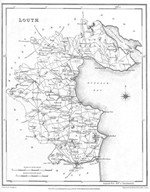So what do we know about the Ancient Boylan clan? We know that a Fourteenth Century poet commented on their horsemanship, we know they came from Flanagan stock, we know their blue eyes were famous, and we know they warred with the McMahons who eventually shrunk the Boylan territory.
I had my Y chromosone tested a year and a half ago when I still couldn't locate my family's last place of residence in Ireland. I hoped it might link me to other Boylan's and, therefore, yield some clues - up until very recently it hadn't helped much. But in the last two weeks I had reasonably close genetic matches to other Boylan's from an area of southern County Cavan (only about 25 miles from Dromin).
But what I find even more surprising is a probable genetic link to the McMahon clan who warred in ancient times with the Boylan's. Whenever I used to see these clan tales in heraldry books I would consider them fables. However, now that I (and I assume my other 2 genetic Boylan "cousins") have shown a strong link (albeit roughly 1000 years ago) to the McMahon clan I am left wondering how many of these stories passed from generation to generation may be true. I am told that in ancient Ireland clans would "foster" the children of their enemies killed in battle. Was this a case of fostering? And if it was who "fostered" who? I guess only time will tell as more Boylan's and McMahon's get genealogical DNA tests. Its amazing what DNA can show!
Oh, and by the way, I don't see any ties yet to the Flanagans!







 Sandbanks Cemetery, otherwise known as Auburn Catholic Cemetery, in
Sandbanks Cemetery, otherwise known as Auburn Catholic Cemetery, in 
